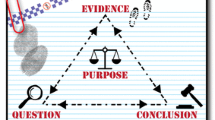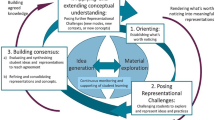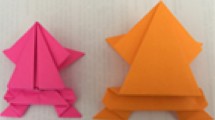Abstract
Initial research has shown that simulating data from models created with computer software may enhance students’ understanding of concepts in introductory statistics; yet, there is little research investigating students’ development of statistical models. The research presented here examines small groups of students as they develop a model for a situation where a music teacher plays ten notes for a student who tries to guess each of the notes correctly. As students constructed their models and described their thinking, their descriptions were narrative in nature, focusing on the story of notes played and guessed. In this context, their focus on narrative appeared to support the development of productive statistical models. In addition, when students investigated pre-built TinkerPlots models, they preferred models that they perceived as more communicative or narrative in nature. These results have important pedagogical implications in terms of designing modeling curriculum.



Similar content being viewed by others
Notes
While some researchers distinguish between narrative and story (e.g., Fuchs, 2015), others use these terms interchangeably. In our work, we use stories and narrative interchangeably.
If the group came up with one of the three models shown then we did not show them that model, opting to show only the two models they did not use in their work.
Email the authors of this paper to obtain the entire problem solving session protocol.
We do not focus on quantitative summaries in this paper, however the majority of students did create models that focused on notes.
References
Avraamidou, L., & Osborne, J. (2009). The role of narrative in communicating science. International Journal of Science Education, 31(12), 1683–1707. https://doi.org/10.1080/09500690802380695.
Braun, V., & Clarke, V. (2006). Using thematic analysis in psychology. Qualitative Research in Psychology, 3(2), 77–101. https://doi.org/10.1191/1478088706qp063oa.
Bruner, J. (1990). Acts of meaning. Cambridge: Harvard University Press.
Clark, M. C., & Rossiter, M. (2008). Narrative learning in adulthood. New Directions for Adult and Continuing Education, 119, 61–70. https://doi.org/10.1002/ace.306.
Cobb, G. W. (2007). The introductory statistics course: A Ptolemaic curriculum? Technology Innovations in Statistics Education, 1(1). http://escholarship.org/uc/item/6hb3k0nz.
Cobb, G. W., & Moore, D. S. (1997). Mathematics, statistics, and teaching. The American Mathematical Monthly, 104(9), 801–823. https://doi.org/10.2307/2975286.
Doerr, H. M., delMas, R., & Makar, K. (2017). A modeling approach to the development of students’ informal inferential reasoning. Statistics Education Research Journal, 16(2), 86–115.
Doerr, H. M., & Pratt, D. (2008). The learning of mathematics and mathematical modeling. In M.K. Heid & G. W. Blume (Eds.), Research on technology and the teaching and learning of mathematics: Research syntheses (pp. 259–285). Charlotte: Information Age Publishing.
Fisher, W. R. (1987). Human communication as narration: Toward a philosophy of reason, value, and action. Columbia: University of South Carolina Press.
Fuchs, H. U. (2015). From stories to scientific models and back: Narrative framing in modern macroscopic physics. International Journal of Science Education, 37(5–6), 934–957. https://doi.org/10.1080/09500693.2015.1025311.
Garfield, J., delMas, B., & Zieffler, A. (2012). Developing statistical modelers and thinkers in an introductory tertiary-level statistics course. ZDM – The International Journal on Mathematics Education, 44(7), 883–898. https://doi.org/10.1007/s11858-012-0447-5.
Gil, E., & Ben-Zvi, D. (2011). Explanations and context in the emergence of students’ informal inferential reasoning. Mathematical Thinking and Learning, 13(1–2), 87–108. https://doi.org/10.1080/10986065.2011.538295.
Hestenes, D. (2010). Modeling theory for math and science education. In R. Lesh, P. L. Galbraith, C. R. Haines & A. Hurford (Eds.), Modeling students’ mathematical modeling competencies: ICTMA 13 (pp. 13–41). New York: Springer.
Klassen, S. (2009). The relation of story structure to a model of conceptual change in science learning. Science & Education, 19, 305–317. https://doi.org/10.1007/s11191-009-9212-8.
Konold, C., & Lehrer, R. (2008). Technology and mathematics education: An essay in honor of Jim Kaput. In L. D. English (Ed.), Handbook of international research in mathematics education (2nd edn., pp. 49–72). Philadelphia: Taylor & Francis.
Konold, C., & Miller, C. (2011). TinkerPlots™ Version 2.3 [Computer Software]. Amherst: Learn Troop.
Laina, V., & Wilkerson, M. (2017). Modeling data by visualizing it. Proceedings of the 10th of the international forum for statistical reasoning, thinking and literacy, Rotorua.
Lave, J. (1988). Cognition in practice: Mind, mathematics and culture in everyday life. New York: Cambridge University Press.
Lehrer, R. (2017). Modeling signal-noise processes supports student construction of a hierarchical image of sample. Statistics Education Research Journal, 16(2), 64–85.
Lesh, R., & Doerr, H. M. (2003). Beyond constructivism: A models and modeling perspective on mathematics problem solving, learning and teaching. Mahwah: Lawrence Erlbaum Associates, Inc.
Mair, M., Greiffenhagen, C., & Sharrock, W. W. (2015). Statistical practice: Putting society on display. Theory, Culture & Society, 33(3), 51–77. https://doi.org/10.1177/0263276414559058.
Morgan, M. S. (2001). Models, stories and the economic world. Journal of Economic Methodology, 8(3), 361–384. https://doi.org/10.1080/13501780110078972.
Nemirovsky, R. (1996). Mathematical narratives, modeling and algebra. In N. Bednarz, C. Kieran & L. Lee (Eds.), Approaches to algebra: Perspectives for research and teaching (pp. 197–220). Dordrecht: Kluwer Academic.
Nolan, D., & Lang, D. T. (2010). Computing in the statistics curricula. The American Statistician, 64(2), 97–107. https://doi.org/10.1198/tast.2010.09132.
Noll, J., & Kirin, D. (2016). Student approaches to constructing statistical models using TinkerPlots™. Technology Innovations in Statistics Education, 9(1). http://escholarship.org/uc/item/05b643r9.
Norris, S. P., Guilbert, S. M., Smith, M. L., Hakimelahi, S., & Phillips, L. M. (2005). A theoretical framework for narrative explanation in science. Science Education, 89(4), 535–563. https://doi.org/10.1002/sce.20063.
Pfannkuch, M., Budgett, S., Fewster, R., Fitch, M., Pattenwise, S., Wild, C., & Ziedins, I. (2016). Probability modeling and thinking: What can we learn from practice? Statistics Education Research Journal, 15(2), 11–37.
Pfannkuch, M., & Wild, C. J. (2000). Statistical thinking and statistical practice: Themes gleaned from professional statisticians. Statistical Science, 15(2), 132–152.
Segel, E., & Heer, J. (2010). Narrative visualization: Telling stories with data. IEEE Transactions on Visualization and Computer Graphics, 16(6), 1139–1148. https://doi.org/10.1109/TVCG.2010.179.
Sinclair, N., Healy, L., & Sales, C. O. R. (2009). Time for telling stories: Narrative thinking with dynamic technology. ZDM - The International Journal on Mathematics Education, 41(4), 441–452. https://doi.org/10.1007/s11858-009-0180-x.
van Oers, B. (1997). On the narrative nature of young children’s iconic representations: Some evidence and implications. International Journal of Early Years Education, 5(3), 237–245. https://doi.org/10.1080/0966976970050305.
Wild, C. J., & Pfannkuch, M. (1999). Statistical thinking in empirical enquiry. International Statistical Review, 67(3), 223–248. https://doi.org/10.1111/j.1751-5823.1999.tb00442.x.
Acknowledgements
The authors gratefully acknowledge the support of National Science Foundation for this CAREER project (NSF REC 1453822). Any conclusions expressed in this material are those of the authors and do not necessarily reflect the views of the NSF. We also wish to thank Andee Rubin for thoughtful feedback on students’ use of narrative.
Author information
Authors and Affiliations
Corresponding author
Rights and permissions
About this article
Cite this article
Noll, J., Clement, K., Dolor, J. et al. Students’ use of narrative when constructing statistical models in TinkerPlots. ZDM Mathematics Education 50, 1267–1280 (2018). https://doi.org/10.1007/s11858-018-0981-x
Accepted:
Published:
Issue Date:
DOI: https://doi.org/10.1007/s11858-018-0981-x




